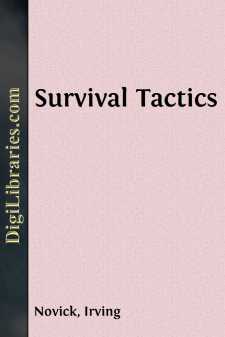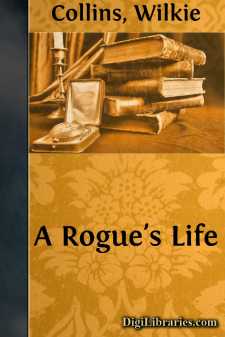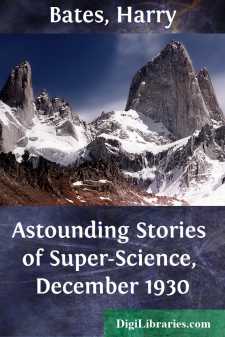Fiction
- Action & Adventure 180
- Biographical 15
- Christian 59
- Classics 6965
- Coming of Age 5
- Contemporary Women 3
- Erotica 8
- Espionage/Intrigue 12
- Fairy Tales, Folklore & Mythology 236
- Family Life 169
- Fantasy 117
- Gay 1
- General 596
- Ghost 32
- Historical 808
- Horror 43
- Humorous 160
- Jewish 25
- Legal 4
- Medical 22
- Mystery & Detective 315
- Political 49
- Psychological 41
- Religious 64
- Romance 159
- Sagas 11
- Science Fiction 730
- Sea Stories 113
- Short Stories (single author) 537
- Sports 10
- Suspense 1
- Technological 8
- Thrillers 2
- Urban Life 31
- Visionary & Metaphysical 1
- War & Military 173
- Westerns 199
Fiction Books
Sort by:
I am the last of my type existing today in all the Solar System. I, too, am the last existing who, in memory, sees the struggle for this System, and in memory I am still close to the Center of Rulers, for mine was the ruling type then. But I will pass soon, and with me will pass the last of my kind, a poor inefficient type, but yet the creators of those who are now, and will be, long after I pass...
more...
by:
Irving Novick
There was a sudden crash that hung sharply in the air, as if a tree had been hit by lightning some distance away. Then another. Alan stopped, puzzled. Two more blasts, quickly together, and the sound of a scream faintly. Frowning, worrying about the sounds, Alan momentarily forgot to watch his step until his foot suddenly plunged into an ant hill, throwing him to the jungle floor. "Damn!" He...
more...
by:
Gilbert Parker
CHAPTER I. "Why don't she come back, father?" The man shook his head, his hand fumbled with the wolfskin robe covering the child, and he made no reply. "She'd come if she knew I was hurted, wouldn't she?" The father nodded, and then turned restlessly toward the door, as though expecting some one. The look was troubled, and the pipe he held was not alight, though he made a...
more...
INTRODUCTION The English language contains a great many words and phrases which are made up of two or more words combined or related in such a way as to form a new verbal phrase having a distinct meaning of its own and differing in meaning from the sum of the component words taken singly. Income and outgo, for example, have quite definite meanings related, it is true, to come and go and to in and out,...
more...
by:
Wilkie Collins
CHAPTER I. I AM going to try if I can't write something about myself. My life has been rather a strange one. It may not seem particularly useful or respectable; but it has been, in some respects, adventurous; and that may give it claims to be read, even in the most prejudiced circles. I am an example of some of the workings of the social system of this illustrious country on the individual native,...
more...
by:
Allan Pinkerton
CHAPTER I. The Arrival in South Norwalk.—The Purchase of the Farm.—A Miser's Peculiarities, and the Villagers' Curiosity. About a mile and a half from the city of South Norwalk, in the State of Connecticut, rises an eminence known as Roton Hill. The situation is beautiful and romantic in the extreme. Far away in the distance, glistening in the bright sunshine of an August morning, roll...
more...
I The Associated Shades Take Action The House-boat of the Associated Shades, formerly located upon the River Styx, as the reader may possibly remember, had been torn from its moorings and navigated out into unknown seas by that vengeful pirate Captain Kidd, aided and abetted by some of the most ruffianly inhabitants of Hades. Like a thief in the night had they come, and for no better reason than...
more...
by:
Harry Bates
batalões turned from the open waters of the lower Tapajos River into the igarapé, the lily-smothered shallows that often mark an Indian settlement in the jungles of Brazil. One of the two half-breed rubber-gatherers suddenly stopped his batalõe by thrusting a paddle against a giant clump of lilies. In a corruption of the Tupi dialect, he called over to the white man occupying the other frail craft....
more...
FLORE (1643) It was about a month after my marriage—and third clerk to the most noble the Bishop of Beauvais, and even admitted on occasions to write in his presence and prepare his minutes, who should marry if I might not?—it was about a month after my marriage, I say, that the thunderbolt, to which I have referred, fell and shattered my fortunes. I rose one morning—they were firing guns for the...
more...
by:
John Ruskin
I. ATHENA CHALINITIS.*(Athena in the Heavens.) * "Athena the Restrainer." The name is given to her as having helpedBellerophon to bridle Pegasus, the flying cloud. LECTURE ON THE GREEK MYTHS OF STORM, GIVEN (PARTLY) IN UNIVERSITY COLLEGE, LONDON, MARCH 9, 1869. 1. I will not ask your pardon for endeavoring to interest you in the subject of Greek Mythology; but I must ask your permission to...
more...











